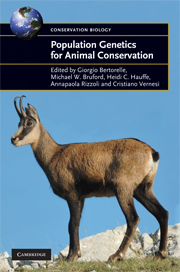Book contents
- Frontmatter
- Epigraph
- Contents
- List of contributors
- Foreword
- Acknowledgements
- 1 Introduction
- Statistical approaches, data analysis and inference
- 2 Statistical methods for identifying hybrids and groups
- 3 How to use MIGRATE or why are Markov chain Monte Carlo programs difficult to use?
- 4 Nested clade phylogeographic analysis for conservation genetics
- 5 A comparison of methods for constructing evolutionary networks from intraspecific DNA sequences
- Molecular approaches and applications
- From genetic data to practical management: issues and case studies
- Future directions in conservation genetics
- Software index
- Species index (common name)
- Species index (Latin name)
- Subject index
3 - How to use MIGRATE or why are Markov chain Monte Carlo programs difficult to use?
from Statistical approaches, data analysis and inference
Published online by Cambridge University Press: 05 July 2015
- Frontmatter
- Epigraph
- Contents
- List of contributors
- Foreword
- Acknowledgements
- 1 Introduction
- Statistical approaches, data analysis and inference
- 2 Statistical methods for identifying hybrids and groups
- 3 How to use MIGRATE or why are Markov chain Monte Carlo programs difficult to use?
- 4 Nested clade phylogeographic analysis for conservation genetics
- 5 A comparison of methods for constructing evolutionary networks from intraspecific DNA sequences
- Molecular approaches and applications
- From genetic data to practical management: issues and case studies
- Future directions in conservation genetics
- Software index
- Species index (common name)
- Species index (Latin name)
- Subject index
Summary
Population genetic analyses often require the estimation of parameters such as population size and migration rates. In the 1960s, enzyme electrophoresis was developed; it was the first method to gather co-dominant data from many individuals in many populations relatively easily. Summary statistics methods, such as allele-frequency based F-statistics (Wright 1951), were used to estimate population genetics parameters from these data sets. These methods matured and expanded into many variants that were enthusiastically accepted by many researchers. F-statistics are still a hallmark of any population genetic study, especially in conservation genetics, although over the years, limitations have become evident (Neigel 2002). Many of these methods use restrictive assumptions, for example, disallowing mutation. F-statistics, such as FST methods, are often employed on pairs of populations; this can lead to biased parameter estimates (see Beerli 2004; Slatkin 2005) and the reuse of data in these pairwise methods is undesirable from a statistical viewpoint.
In 1982, Sir John Kingman developed the coalescence theory (Kingman 1982a, b). His overview of the developments of this theory (Kingman 2000) gives an interesting insight into the development of new ideas. This new development opened the door to methods in population genetics that go beyond the F-statistics methods and have led to several theoretical breakthroughs (Hein et al. 2005; although inferences based on coalescence theory were not practicable until about 1995 because of computational constraints). In recent years, computer-intensive programs that can estimate parameters using genetic data under various coalescent models have been developed; for example, programs that estimate gene flow (Beerli and Felsenstein 1999, 2001; Bahlo and Griffiths 2000; Wilson et al. 2003; De Iorio and Griffiths 2004; Hey and Nielsen 2004; Beerli 2006; Ewing and Rodrigo 2006; Kuhner 2006). These programs use different models and different approaches, but in all of them, the quantities of interest are difficult to calculate. Very generally, the goal of these applications is to calculate the probability of the parameters of the chosen model given the data.
- Type
- Chapter
- Information
- Population Genetics for Animal Conservation , pp. 42 - 79Publisher: Cambridge University PressPrint publication year: 2009
- 148
- Cited by



